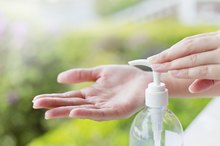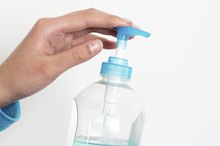What does fact checked mean?
At Healthfully, we strive to deliver objective content that is accurate and up-to-date. Our team periodically reviews articles in order to ensure content quality. The sources cited below consist of evidence from peer-reviewed journals, prominent medical organizations, academic associations, and government data.
- Endocrinology: Triclocarban Enhances Testosterone Action
- Endocrinology: Triclocarban Enhances Testosterone Action
The information contained on this site is for informational purposes only, and should not be used as a substitute for the advice of a professional health care provider. Please check with the appropriate physician regarding health questions and concerns. Although we strive to deliver accurate and up-to-date information, no guarantee to that effect is made.
The Disadvantages of Hand Sanitizers
Hand sanitizers are available in liquid form as well as towelettes and wipes. People use hand sanitizers to eliminate illness-causing germs and in situations where using soap and water is inconvenient, such as wilderness camping. The Outdoor Action Program at Princeton University notes that alcohol-based sanitizers kill up to 99 percent of bacteria and clean hands in only a few seconds 1. Hand sanitizers also have some important disadvantages.
Cleaning Effectiveness
Using hand sanitizers does not replace hand washing, as explained by the Capital Region Board of Cooperative Educational Services (BOCES). If hands have visible dirt, these sanitizers don't remove it very well. When hand sanitizers are used in schools or other facilities, the budget still must include money to buy soap. Additionally, consumer antiseptic use has not been demonstrated as being more effective than soap and water in any place other than a health care setting.
- Using hand sanitizers does not replace hand washing, as explained by the Capital Region Board of Cooperative Educational Services (BOCES).
- When hand sanitizers are used in schools or other facilities, the budget still must include money to buy soap.
Endocrine System Disruption
Hand Sanitizer & Its Chemical Properties
Learn More
Antibacterial hand sanitizers may contain triclosan or triclocarban, agents that kill both bad and beneficial bacteria. These chemicals can act as endocrine disruptors and may be a factor in early puberty, as noted by White Hutchinson Leisure & Learning Group. A study published in the March 2008 issue of "Endocrinology" indicated that triclocarban enhances testosterone action 2.
Danger to Children
Most liquid hand sanitizers contain a large amount of ethyl or isopropyl alcohol, and must be kept out of reach of children unless adults are supervising. Snopes.com has confirmed reports of children needing medical treatment after consuming small amounts of these sanitizers.
Flammable Products
Ingredients in Hand Sanitizer
Learn More
Because of the high alcohol content of most hand sanitizing liquids, these substances are flammable, according to University of Rochester Facilities and Services. People must keep these sanitizers away from open flame, including candles and gas appliances. Hand sanitizers also should not be used when cooking on a barbecue grill. The flammable nature of hand sanitizers also makes them hazardous waste, and they must be disposed of and stored according to Occupational Health and Safety Administration (OSHA) guidelines.
- Because of the high alcohol content of most hand sanitizing liquids, these substances are flammable, according to University of Rochester Facilities and Services.
- The flammable nature of hand sanitizers also makes them hazardous waste, and they must be disposed of and stored according to Occupational Health and Safety Administration (OSHA) guidelines.
Related Articles
References
- Princeton University: Keeping Clean on the Trail
- Endocrinology: Triclocarban Enhances Testosterone Action
- White Hutchinson: Consider Nontoxic Hand Sanitizers
- Centers for Disease Control and Prevention. CDC Statement for Healthcare Personnel on Hand Hygiene during the Response to the International Emergence of COVID-19. Updated March 14, 2020.
- Centers for Disease Control and Prevention. Chemical disinfectants. Updated September 18, 2016.
- Centers for Disease Control and Prevention. When and How to Wash Your Hands. Updated October 3, 2019.
- Vermeil T, Peters A, Kilpatrick C, Pires D, Allegranzi B, Pittet D. Hand hygiene in hospitals: anatomy of a revolution. J Hosp Infect. 2019;101(4):383-392. doi:10.1016/j.jhin.2018.09.003
- McEgan R, Danyluk MD. Evaluation of aqueous and alcohol-based quaternary ammonium sanitizers for inactivating Salmonella spp., Escherichia coli O157:H7, and Listeria monocytogenes on peanut and pistachio shells. Food Microbiol. 2015;47:93-98. doi:10.1016/j.fm.2014.11.010
- Inaida S, Shobugawa Y, Matsuno S, Saito R, Suzuki H. Delayed norovirus epidemic in the 2009-2010 season in Japan: potential relationship with intensive hand sanitizer use for pandemic influenza. Epidemiol Infect. 2016;144(12):2561-2567. doi:10.1017/S0950268816000984
- Stebbins S, Cummings DA, Stark JH, et al. Reduction in the incidence of influenza A but not influenza B associated with use of hand sanitizer and cough hygiene in schools: a randomized controlled trial. Pediatr Infect Dis J. 2011;30(11):921-926. doi:10.1097/INF.0b013e3182218656
- Azor-Martinez E, Yui-Hifume R, Muñoz-Vico FJ, et al. Effectiveness of a hand hygiene program at child care centers: A cluster randomized trial. Pediatrics. 2018;142(5):e20181245. doi:10.1542/peds.2018-1245
- Blaney DD, Daly ER, Kirkland KB, Tongren JE, Kelso PT, Talbot EA. Use of alcohol-based hand sanitizers as a risk factor for norovirus outbreaks in long-term care facilities in northern New England: December 2006 to March 2007. Am J Infect Control. 2011;39(4):296-301. doi:10.1016/j.ajic.2010.10.010
- Wilson AM, Reynolds KA, Jaykus LA, Escudero-Abarca B, Gerba CP. Comparison of estimated norovirus infection risk reductions for a single fomite contact scenario with residual and nonresidual hand sanitizers. Am J Infect Control. 2019;S0196-6553(19)30846-6. doi:10.1016/j.ajic.2019.09.010
- Centers for Disease Control and Prevention. Handwashing: Clean hands save lives. Updated January 14, 2020.
Resources
Writer Bio
Shelley Moore is a journalist and award-winning short-story writer. She specializes in writing about personal development, health, careers and personal finance. Moore has been published in "Family Circle" magazine and the "Milwaukee Sentinel" newspaper, along with numerous other national and regional magazines, daily and weekly newspapers and corporate publications. She has a Bachelor of Science in psychology.









